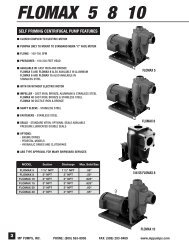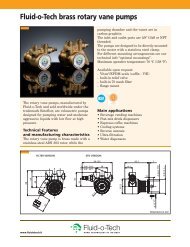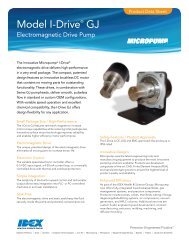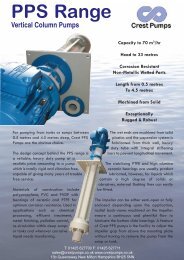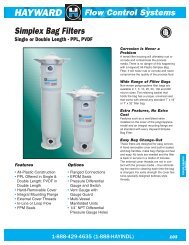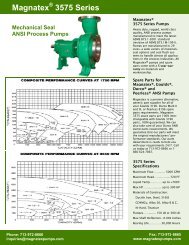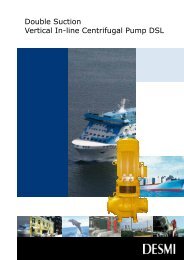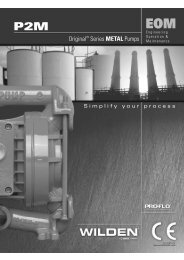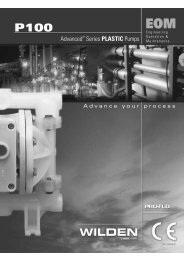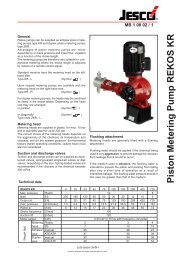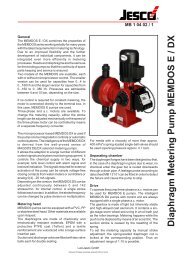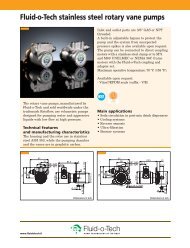P15/PV15 - Process Pumps
P15/PV15 - Process Pumps
P15/PV15 - Process Pumps
- No tags were found...
You also want an ePaper? Increase the reach of your titles
YUMPU automatically turns print PDFs into web optimized ePapers that Google loves.
Section 1CAUTIONS—READ FIRST!CAUTION: Do not apply compressed air to theexhaust port — pump will not function.CAUTION: Do not over-lubricate air supply —excess lubrication will reduce pump performance.Pump is pre-lubed.TEMPERATURE LIMITS:Neoprene –17.7°C to 93.3°C 0°F to 200°FBuna-N –12.2°C to 82.2°C 10°F to 180°FEPDM –51.1°C to 137.8°C –60°F to 280°FViton ® –40°C to 176.7°C –40°F to 350°FSaniflex –28.9°C to 104.4°C –20°F to 220°FPolytetrafluoroethylene (PTFE)4.4°C to 104.4°C 40°F to 220°FPolyurethane –12.2°C to 65.6°C 10°F to 150°FTetra-Flex PTFE w/Neoprene Backed4.4°C to 107.2°C 40°F to 225°FTetra-Flex PTFE w/Nordel ® Backed-10°C to 137°C 14°F to 280°FNOTE: Not all materials are available for allmodels. Refer to Section 2 for material optionsfor your pump.CAUTION: When choosing pump materials, besure to check the temperature limits for all wettedcomponents. Example: Viton ® has a maximumlimit of 176.7°C (350°F) but polypropylene has amaximum limit of only 79°C (175°F).CAUTION: Maximum temperature limits arebased upon mechanical stress only. Certainchemicals will significantly reduce maximumsafe operating temperatures. Consult ChemicalResistance Guide (E4) for chemical compatibilityand temperature limits.WARNING: Prevention of static sparking — Ifstatic sparking occurs, fire or explosion couldresult. Pump, valves, and containers must begrounded to a proper grounding point whenhandling flammable fluids and wheneverdischarge of static electricity is a hazard.CAUTION: Do not exceed 8.6 bar (125 psig) airsupply pressure.CAUTION: The process fluid and cleaning fluidsmust be chemically compatible with all wettedpump components. Consult Chemical ResistanceGuide (E4).CAUTION: Do not exceed 82°C (180°F) air inlettemperature for Pro-Flo V models.CAUTION: <strong>Pumps</strong> should be thoroughly flushedbefore installing into process lines. FDA andUSDA approved pumps should be cleaned and/or sanitized before being used.CAUTION: Always wear safety glasses whenoperating pump. If diaphragm rupture occurs,material being pumped may be forced out airexhaust.CAUTION: Before any maintenance or repair isattempted, the compressed air line to the pumpshould be disconnected and all air pressureallowed to bleed from pump. Disconnect allintake, discharge and air lines. Drain the pumpby turning it upside down and allowing any fluidto flow into a suitable container.CAUTION: Blow out air line for 10 to 20 secondsbefore attaching to pump to make sure all pipelinedebris is clear. Use an in-line air filter. A 5μ (micron)air filter is recommended.NOTE: When installing PTFE diaphragms, it isimportant to tighten outer pistons simultaneously(turning in opposite directions) to ensure tight fit.(See torque specifications in Section 7.)NOTE: Cast Iron PTFE-fitted pumps comestandard from the factory with expanded PTFEgaskets installed in the diaphragm bead of theliquid chamber. PTFE gaskets cannot be re-used.Consult PS-TG for installation instructions duringreassembly.NOTE: Before starting disassembly, mark a linefrom each liquid chamber to its corresponding airchamber. This line will assist in proper alignmentduring reassembly.CAUTION: Pro-Flo ® pumps cannot be used insubmersible applications. Pro-Flo V is availablein both submersible and non-submersible options.Do not use non-submersible Pro-Flo V modelsin submersible applications. Turbo-Flo pumpscan also be used in submersible applications.CAUTION: Tighten all hardware prior to installation.WIL-10110-E-02 8/06 1 WILDEN PUMP & ENGINEERING, LLC



